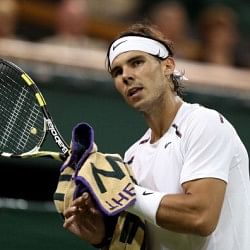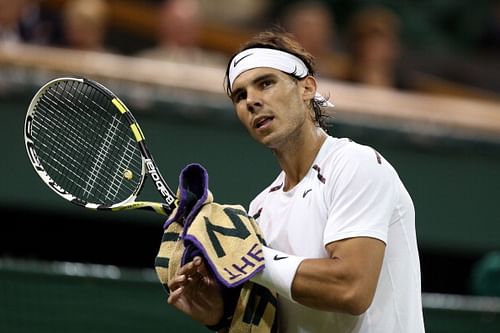
Remembering the thunder and the flash: Rafael Nadal’s comeback

It has been three weeks since the return of the King of Clay. In that time, the tennis world has yet to see Rafael Nadal on any grand stage besides the ATP 250 events (VTR and Brazil Opens). The former World Number 1 and 11-time Grand Slam champion is in the process of making a comeback in his bid to introduce new records to the history book. Healing from tendinitis, the Spaniard has come back after 7 months off tour – a bit rusty and a bit ill. Not yet at 100%, Nadal has reached the finals of the VTR and Brazil Opens, winning the title in Brazil. Just how is he doing now? Let’s put his results into perspective.
Forehand
The left-handed Spaniard is widely known for his topspin forehand that allows him to produce exquisite shots on the court. Though not as powerful as Federer’s, Nadal’s forehand shots easily bounce up to shoulder height on clay, causing trouble for many opponents. In fact, in his autobiography, Nadal revealed that his strategy against Federer is to hit EVERY shot to Federer’s backhand – the high bounce forces weak returns. Consequently, many analysts credit Nadal’s record 7 French Open titles to his unique forehand.
On his return from the injury hiatus, to the relief of many fans, Nadal has still got it. Although his shots are not as deep and do not skip off the lines as well as they used to, Nadal still has plenty of aggressive topspin in his play. In the VTR Open final, his topspin forehand kept his opponent Horacio Zeballos meters behind the baseline. As Nadal’s knee gets better, he will be able to put more power and produce more consistent shots by utilizing his lower body more adeptly.
Backhand
Nadal’s backhand has been one of his most consistent weapons that made him one of the best retrievers on tour. The Spaniard uses his backhand, capable of producing a lot of topspin of its own, to push back his opponents, set up points and hit winners. His backhand is arguably his best and favourite weapon during baseline duels, capable of holding back aggressive players such as Federer.
However, since resurfacing on the court, Nadal’s backhand has been very weak. His shots have lost the aggressive touch; much of his side of the court is left open, causing Nadal to run around more. Although the former World Number 1 won his match against David Nalbandian 6-3, 6-2 to recapture his first Brazil Open title in 8 years, there was a striking difference between his performance in the final compared to his quarterfinal match against Nalbandian in Indian Wells last year. The King of Clay needs to adjust his backhand in order to defend his French Open title against the rest of the Big Four.
Serve

Although Nadal has never been able to set records in the serve speed department, and was often criticized for having a poor serve at the dawn of his career, the Spaniard, since 2008, has been serving solidly and effectively. In 2010 and 2011, Nadal’s first serve was able to consistently reach over 120 mph – his serve speed was attributed as the cause of his dominance at the 2010 US Open. To put that into perspective, his serve was slightly faster than that of tennis greats such as Federer and Murray.
Unfortunately, his dominant serve was nowhere to be seen during the past 3 weeks. In his semi-final match against Jeremy Chardy at the VTR Open, Nadal’s second serve stayed low and slow. Chardy was able to attack on many second serves. Its vulnerability was extremely apparent against Carlos Berlocq in the Brazil Open quarter-finals too, where Berlocq pushed Nadal to 3 sets and almost pulled off an upset. The Spaniard will need to deal with his knee and become more aggressive on his serve.
Style
Nadal needs to return to his old self that impressed the world in the 2011 French Open final against Federer, where he utilized aggression and mental toughness to triumph over the Maestro, who was playing some of his best tennis. The King of Clay needs to work exclusively on the consistency and mentality that helped him dominate for almost a decade. The Spaniard will be working on his serve and backhand to control the court with more vigour and confidence.
Injuries are no trivial issues to athletes, and comebacks are the hardest tasks players on tour face. One mistake during a match in which a player pushes himself or herself too hard may result in further injuries. Nadal’s decision to return in ATP 250 tournaments on clay is definitely a good decision, as clay puts less strain on his body. Expect the Spaniard to rediscover his former self in the next few weeks as he battles in Acapulco.
If all goes well, Indian Wells will see Nadal storming back to his first hardcourt tournament in almost a year. However, if that is not the case, do not fret. The Spaniard’s top priority at the moment is to regain his form – causing a new injury will make things a lot worse – because the hardcourts in California are less forgiving than Nadal’s beloved clay.
Many have speculated that the King of Clay will choose to change his style to a more aggressive one. The logic is that Nadal would prefer to stand closer to the baseline and finish points faster, thus reducing the strain on his knees. Nadal fans should be happy that Nadal thinks otherwise. “I’m not that good to be able to reprogram my style, I only have one, it’s virtually impossible to change it. I am confident that my body will hold up.” The Spaniard instead chose to change the strings on his racquets to produce even more topspin to complement his game.
Future Outlook

Nadal is definitely still in the process of returning to top form, evidently because his current game is somewhat deficient compared to that of a top 10 player. Given that Nadal has made successful comebacks in 2006 and 2009, it is safe to say that the world will see Nadal, who is only 26 years old, on more grand stages at Slams and Masters. How well will he do? Nadal is probably the only one who can truly determine that.